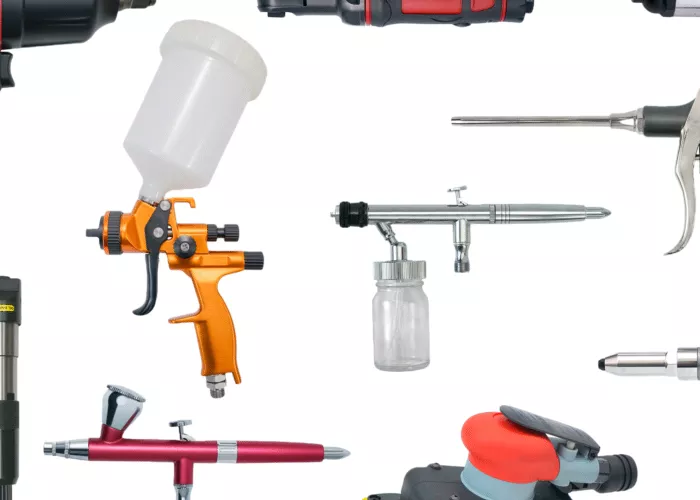Pneumatic tools, also known as air tools, are powered by compressed air rather than electricity or manual effort. These tools are widely used in industries such as automotive, construction, manufacturing, and maintenance due to their efficiency, durability, and ease of use. Unlike their electric or battery-operated counterparts, pneumatic tools rely on an external air compressor to function, making them a staple in high-demand environments where consistent power and performance are essential.
How Do Pneumatic Tools Work
The core principle behind pneumatic tools is the conversion of compressed air energy into mechanical work. The process involves an air compressor that generates and stores pressurized air, which is then directed to the tool through a hose. Upon activation, the tool’s internal mechanisms, such as pistons, turbines, or vanes, harness the kinetic energy of the air to perform a specific task. This simple yet effective mechanism enables pneumatic tools to deliver high torque and power while remaining lightweight and relatively maintenance-free.
Types of Pneumatic Tools and Their Applications
Pneumatic tools come in a variety of forms, each designed to perform specific tasks efficiently. Below are some of the most common types and their applications:
1. Pneumatic Drills
Pneumatic drills are used for drilling holes in various materials, including wood, metal, and concrete. They are commonly found in industrial assembly lines and automotive workshops due to their high-speed operation and consistent performance.
2. Pneumatic Impact Wrenches
Impact wrenches are widely used in automotive repair shops and assembly lines. These tools deliver high torque output with minimal effort, making them ideal for loosening and tightening nuts and bolts, especially in applications requiring rapid fastening.
3. Pneumatic Grinders
Pneumatic grinders are used in metalworking and fabrication industries for grinding, polishing, and deburring metal surfaces. Their lightweight nature and high rotational speed make them perfect for achieving precision finishes.
4. Pneumatic Sanders
Used extensively in woodworking and automotive industries, pneumatic sanders provide smooth finishing on surfaces. They operate with high-speed motion to remove imperfections and prepare materials for painting or further treatment.
5. Pneumatic Nail Guns
Nail guns powered by compressed air are commonly used in construction and carpentry for fastening materials quickly and efficiently. These tools significantly reduce labor effort and increase productivity compared to manual hammering.
6. Pneumatic Spray Guns
Pneumatic spray guns are utilized in painting and coating applications, offering a fine, even distribution of paint or other liquid materials. They are preferred for automotive painting, furniture finishing, and industrial coating processes.
7. Pneumatic Chisels and Hammers
These tools are used in demolition, metal shaping, and masonry applications. Pneumatic hammers provide powerful percussive force, making them effective for breaking concrete, carving stone, or chiseling metal.
Advantages of Pneumatic Tools
Pneumatic tools offer several advantages over their electric or manual counterparts, making them a preferred choice in many industries:
High Power-to-Weight Ratio – These tools are lightweight yet powerful, allowing users to work for extended periods with less fatigue.
Durability and Longevity – With fewer moving parts and no electrical components, pneumatic tools have a longer lifespan and require minimal maintenance.
Consistent Performance – Unlike battery-powered tools that can lose efficiency over time, pneumatic tools maintain a constant performance level as long as there is a sufficient air supply.
Safety – Pneumatic tools do not generate sparks, making them safer to use in explosive or hazardous environments.
Cost-Effective – Since air tools have a simpler design, they are often more affordable than electric tools in terms of initial cost and maintenance.
Limitations of Pneumatic Tools
Despite their many benefits, pneumatic tools also have some limitations:
Dependency on Air Compressor – These tools require a steady supply of compressed air, meaning an air compressor must always be available and functioning.
Limited Portability – Due to their reliance on an air compressor and air hoses, pneumatic tools are less portable compared to cordless electric tools.
Noise Levels – Air compressors and pneumatic tools can be noisy, necessitating the use of hearing protection in certain work environments.
Maintenance and Safety Considerations
To ensure optimal performance and safety, proper maintenance of pneumatic tools is crucial. Below are key maintenance and safety tips:
Maintenance Tips
Regular Lubrication – Apply oil to moving parts to prevent wear and tear.
Clean Air Supply – Use clean, dry, and properly filtered air to avoid internal damage.
Check Hoses and Fittings – Inspect for leaks, cracks, or loose connections to maintain efficiency and prevent accidents.
Proper Storage – Store tools in a dry and clean environment to prevent rust and contamination.
Safety Tips
Wear Personal Protective Equipment (PPE) – Use safety glasses, gloves, and hearing protection when operating pneumatic tools.
Secure Workpieces – Ensure the material being worked on is firmly clamped or secured to prevent movement.
Avoid Overloading – Do not exceed the recommended pressure levels to prevent tool damage or injury.
Disconnect When Not in Use – Always disconnect tools from the air supply when performing maintenance or changing accessories.
Conclusion
Pneumatic tools play an essential role in modern industry, offering unparalleled efficiency, power, and durability. Their reliance on compressed air makes them a cost-effective and reliable alternative to electric tools in demanding work environments. While they require an air compressor and periodic maintenance, their advantages in terms of performance and longevity make them an invaluable asset in construction, manufacturing, and automotive sectors. By understanding their working principles, applications, and maintenance requirements, users can maximize the benefits of pneumatic tools while ensuring safe and effective operation.

